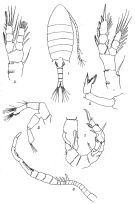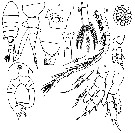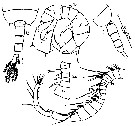|
|
 |
|
Calanoida ( Order ) |
|
|
|
Diaptomoidea ( Superfamily ) |
|
|
|
Pseudodiaptomidae ( Family ) |
|
|
|
Pseudodiaptomus ( Genus ) |
|
|
| |
Pseudodiaptomus hickmani Sewell, 1912 (F,M) | |
| | | | | | | Syn.: | no Pseudodiaptomus hickmani : Dakin & Colefax, 1940 (p.89, figs.F,M) | | | | Ref.: | | | Sewell, 1912 (p.364, figs.F,M); 1924 (p.786); 1932 (p.235); Marsh, 1933 (p.37, figs.F,M); Silas, 1972 (p.648); Ranga Reddy & Radhakrishna, 1982 (p.262, Redescr.F,M, figs.F,M) |  Issued from : R.B.S. Sewell in Rec. Indian Mus., 1912, 7. [Pl.XXII, Figs.1-7]. Female (from Bay of Bengal): 1, habitus (dorsal); 2, A2; 3, P1; 4, P2; 5, P5. Nota: Abdomen and caudal rami contained twice in the length of the cephalothorax. Head and 1st thoracic segment separate, 4th and 5th separate.Rostrum bfid with long and delicate spines. Abdomen 4-segmented, the first three of which are armed posteriorly with a row of triangular teeth extending across the dorsal surface. Proportional lengths of urosomites and furca as 10:4:6:4:7. Caudal ramus 3 times as long as wide. Genital operculum produced posteriorly in a single spine on the right side; On the right side of the segment is a blunt spinous process and anterior to the genital orifice is a curved row of needle-shaped spines, which terminates laterally above mentioned process; dorsally the segment is armed on each side
Male: 6, right A1; 7, P5.
Nota: Abdomen 5-segmented, of which the 2nd, 3rd and 4th armed posteriorly with a complete ring of triangular teeth. Proportional lengths of urosomites and furca as 2:5:5:5:3:5. The grasping A1 21-segmented; the knee-joint occurs between the 18th and 19th, the 13th to 17th segments are swollen.
|
 Issued from : Y. Ranga Reddy & Y. Radhakrishna in Hydrobiologia, 1982, 87. [p.263, Plate III, Figs. 1-11]. Female (from 16)32'-16°47'N, 81°4'-81°22'E): 1, habitus (dorsal); 2, postrior part of prosome and urosome with spermatophore (lateral); 3, posterior segment of prosome and genital segment (lateral); 4, segment genital (ventral); 5, caudal ramus; 6 & 6a, A1 and its modified seta; 7, P1; 8, P2; 9, P4; 10, P5; 11, egg sac. Nota: Rostrum strongly developed with 2 long acute spines overreaching the 2nd segment of A1. - Prosme twice the length of urosome. - Head and 1st pedigerous segment separate, 4th and 5th pedigeous segments fused. - Posterolateral corners of the 5th pedigerous segment rounded with a sharp, posterolaterally-directed spine; a few short hairs occur on the margin internal to the spine. - Urosome 4-segmented. - Genital segment slightly asymmetrical, proximally swollen with a short, strong spine on the right side; the armature of this segment is more complex than described by Sewell. - Urosomites together with the caudal rami are in the proportion of 35 : 17 : 19 : 16 : 25. - Caudal rami symmetrical, somewhat divergent, 23.3 times as long as broad with long coarse hairs on their inner margins. The five caudal setae are jointed; the middle seta the longest; a small sensory bristle lies between the inner 2 setae. - A1 21-segmented, reaching a little beyond the posterior margin of prosome. - The structural details of A2 and oral parts quite similar to those of P. binghami. Sewell'sremark that A2 of P. hickmanidiffer from others in possessing a row of spine-like processes on the margin of the last segment of the endopodite appears to be not well-founded as this character is shared by other species. - P1- P4 are identical with P. binghami but for the spine pattern of the basipodite segments. In P1, 1 or 2 strong spines , present on the outer margin of coxa, are absent in other species. - P5 asymmetrical, the left leg, particularly its 2 exopoditesegments, being more slender than their counterparts of the right leg. Each leg consists of 4 segments, 2 each of basipodite and exopodite. Coxa naked. Basis bears 1 seta on the posterior face. Exopodite 1 slightly over twice as long as broad with a small spine at the distal outer corner. Exopodite 2 has 1 spine at about its distal corner, and the segment proper ends in an out-curved, claw-like process serrated on both margins. Between this and the outer spine is a large spine with a lobe-like serrated process at its base on the inner side. - The ovigerous female bears a single large, compact efgg sac, furrowed in the middle owing to the compression of urosome, with 24-38 individual eggs.
|
 Issued from : Y. Ranga Reddy & Y. Radhakrishna in Hydrobiologia, 1982, 87. [p.263, Plate III, Figs. 12-15]. Male: 12, posterior part of prosome and urosome (dorsal); 13, same (lateral); 14 & 14a, right A1 and its segments 9-14; 15, P5 (posterior view). Nota: Prosome as in the female except that the right spine of the 5th pedigerous segment is comparatively larger than its left counterpart and both are backwardly directed. - Urosome 5-segmented; the posterodorsal margin of segments 2-4 with short spines; the 4 midorsal spines of 4th segment distinctly larger. - Genital segment bears at its distal right corner a few small spines arranged in a short transverse row. In the lateral view from the left side, the 2nd urosomite, in addition, shows a few minute spines arranged in 2 short transverse rows. - Caudal rami and setae as in the female. - All appendages except for the right A1 and P5 similar to those of the female. - Right A1 21-segmented, with 3 segments distal to the geniculation; segments 13-17 swollen; segment 3 with a long jointed aesthetasc besides 2 setae; segments 10-13 with a spine each, the spine on segment 10 characteristically bifid and hoohed; segment 17 with an unarmed tooth plate, overlapping the proximal part of the succeeding segment. The tooth plate on segment 18 with long, straight spine-like teeth in the proximal 2/3. Segment 19 has 2 unarmed 'tooth plates'. - P5 asymmetrical, biramoius; basipodite 2-segmented, exopodite 3-segmented in the right leg and 2-segmented in the left. Right leg with coxa naked; basis quite larger than coxa and bears on its outer aspect a Y-shaped spinous process (i.e. endopodite), the two arms of which are nearly of equal length; basis has near the distal outer margin a few spinules arranged in a short transverse row, and 1 short seta at about the centre of the segment on the posterior face. Exopodite 1 has on the outer distal angle a Y-shaped spinous process, the outer arm of which has a short subapical spine; the segment also has a row of short blunt spines on its proximal inner margin. Exopodite 2 longer than broad, having on its distal outer region a short thick spine with serrated margins; near this spine lie a few minute spines on the outer margin; at the middle of the inner margin of the same segment lie a short blunt spinous projection and 1 seta. Exopodite 3 bent inward, 'sickle-shaped', apically drawn out into a slender spinous process, and having on the proximal inner side a pair of short setae, one of which lies on a small lobe; the inner margin of the segment, distal to the lobe, serrated. Left leg with coxa and basis as in the right leg; the endopodite long, unjointed and 'fringed'. Exopodite 1 has a small spine at its distal corner. Exopodite 2 narrow at its base and expands distally into a large thin plate, whose ornamentation can be best understood from the figure. - Colour: Light brown in preserved specimen. A few orange red spots at the base of Mxp and on the ventral part of the anal segment.
| | | | | Compl. Ref.: | | | Sewell, 1948 (p.323); Dussart & Defaye, 1983 (p.31); Sarkar & al., 1986 (p.178); Madhupratap & Haridas, 1986 (p.105, tab.2); Walter, 1986 (p.133); 1986 a (p.503); 1987 (p.367); Ramaiah & al., 1996 (p.3) | | | | NZ: | 1 | | |
|
Distribution map of Pseudodiaptomus hickmani by geographical zones
|
| | | | | | | Loc: | | | India, Lake Kolleru, at Kolletikota, Chilka Lake, Salt Lakes, Calcutta, Hooghly estuary, Diamond Harbour, Burma, Hinze Basin | | | | N: | 5 | | | | Lg.: | | | (80) F: 1,26-1,37; (81) F: 1,37; M: 1,3; (1193) F: 1,31-1,42; M: 1,10-1,19; {F: 1,26-1,42; M: 1,10-1,30} | | | | Rem.: | Limnetic & brackish, estuary.
For Sewell (1912) certain identifications in the Indian Ocean like P. serricaudatus could belong to this new species.
In Ramosus species group (hickmani subgroup) after Walter & al. 2006, p.203.
See remarks in P. sulawesiensis (Nishida & Rumengan, 2005, p.31).
For Ranga Reddy & Radhakrishna (1982, p.264) a critical comparison of the description of P. hickmani with that of Sewell (1912) reveals a few minor differences.
Previous records: Sewell (1948, p.422), relying on Dakin & Colefax (1932, 1940) and Nicholls (1944), stated that this species was recorded from the south-east and south coasts of Autralia. However, Bayly (1966) established that what the above authors reported P. hickmani is in fact different species, P. colefaxi. This shows that the distribution of P. hickmani does not extend to Australia. | | | Last update : 02/03/2016 | |
|
|
 Any use of this site for a publication will be mentioned with the following reference : Any use of this site for a publication will be mentioned with the following reference :
Razouls C., Desreumaux N., Kouwenberg J. and de Bovée F., 2005-2025. - Biodiversity of Marine Planktonic Copepods (morphology, geographical distribution and biological data). Sorbonne University, CNRS. Available at http://copepodes.obs-banyuls.fr/en [Accessed December 17, 2025] © copyright 2005-2025 Sorbonne University, CNRS
|
|
 |
 |






